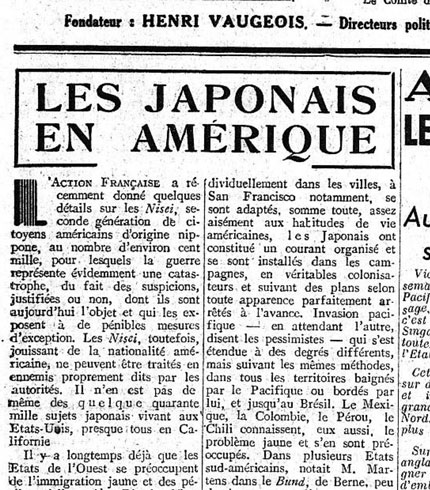By Jonathan van Harmelen
The story of the wartime incarceration of Japanese Americans is not only a part of U.S. history, but also a part of global history. As many Issei remained in touch with families in Japan, news of the wartime incarceration traveled across the Pacific and even became a propaganda tool in Japan. As I note in my previous article on Dutch articles on the incarceration (DN, Jun 2019), many European newspaper outlets across the Atlantic also showed interest in the story of the wartime incarceration. Like the Netherlands, numerous French journalists and writers published articles on the incarceration of Japanese Americans. However, even more shocking is studying the surviving French newspapers from the wartime period that reported on the incarceration as it occurred. Throughout the years of occupation and liberation, French writers repeatedly referenced the incarceration as a topic of interest.
In June 1940, following a Blitzkrieg invasion by Nazi Germany, France capitulated and the French government signed an armistice with Adolf Hitler on June 22, 1940. France was divided up into an “occupied” zone under direct German rule which represented 60% of its territory and a smaller “unoccupied” zone controlled by the authoritarian “Vichy” government of Maréchal Philippe Pétain. The “unoccupied” zone remained formally neutral but was unwilling or unable to resist German demands.
Ultimately, in November 1942, following the Anglo-American invasion of French North Africa, German troops occupied all of metropolitan France. The Fall of France led to an agreement in September 1940 between the Vichy regime and Japan to allow Japanese troops into northern French Indochina, an incursion followed by a full-scale Japanese occupation a year later. Ironically, at this time, the French government arrested the Japanese population of its colony of New Caledonia, shipping them in cages to Australia where they remained interned until the end of the war.
The dominance of pro-Axis forces in France and the French empire would also influence media portrayals of Japan and indirectly, of Japanese Americans. Throughout 1940-1, French media outlets published stories about the Japanese American community, highlighting the tension facing the community amidst the coming of war. On December 15th, 1940, the magazine “7 Jours,” which started under the Vichy regime in Fall 1940 and would fold shortly after the Liberation, ran one of the first articles on Japanese Americans. Titled “100,000 Nisei inquiètent 6 millions de Californiens,” or “100,000 Nisei trouble 6 million Californians,” the article discusses the history of discrimination facing Japanese Americans and the accusations of the Japanese community as a “fifth column.” In his concluding remarks, the author posits to readers “What would the Nisei do?” in the event of war between the U.S. and Japan, leaving the question intentionally unanswered. The theme of loyalty would remain one of the central topics of French publications on the Japanese American community.
On July 6, 1941, the Saigon-based newspaper “Le Nouvelliste d’Indochine” published a translated article from “The Pictorial Orient,” an English-language magazine printed by the “Asahi Shinbun” in Tokyo. Titled “Japanese Americans – Children of Two Families,” its author G.W. Gorman begins the article by recounting a conversation with a woman, implied to be Japanese American, who works with a Japanese shipping company in Tokyo. She shares her concerns over returning to her parents in the United States amidst rising tensions between the two countries. The author uses her story to underline the presence of 30,000 Nisei living in Japan, many of whom are there for education. For many Nisei like the young woman, the author explains that the choice of citizenship between Japan and the U.S. is an issue fraught with tension, as racism in the United States and overtures by the Japanese government push the Japanese American community to support Japan. Yet, the author also points out that many Issei wish to remain Americans and notes that Issei families are the largest agricultural producers on the U.S. West Coast. Concluding with a quote from Japanese Ambassador Kichisaburo Nomura, the author notes that most of the 30,000 Japanese Americans in Japan will ultimately return to the United States, asserting that Japanese Americans are generally loyal to the U.S. and that their adoption of American culture has led to their ostracism in Japan.
to be continued
Jonathan van Harmelen is a PhD student in history at UC Santa Cruz.
This article was originally published in discovernikkei.org, a project of the Japanese American National Museum, Los Angeles.



